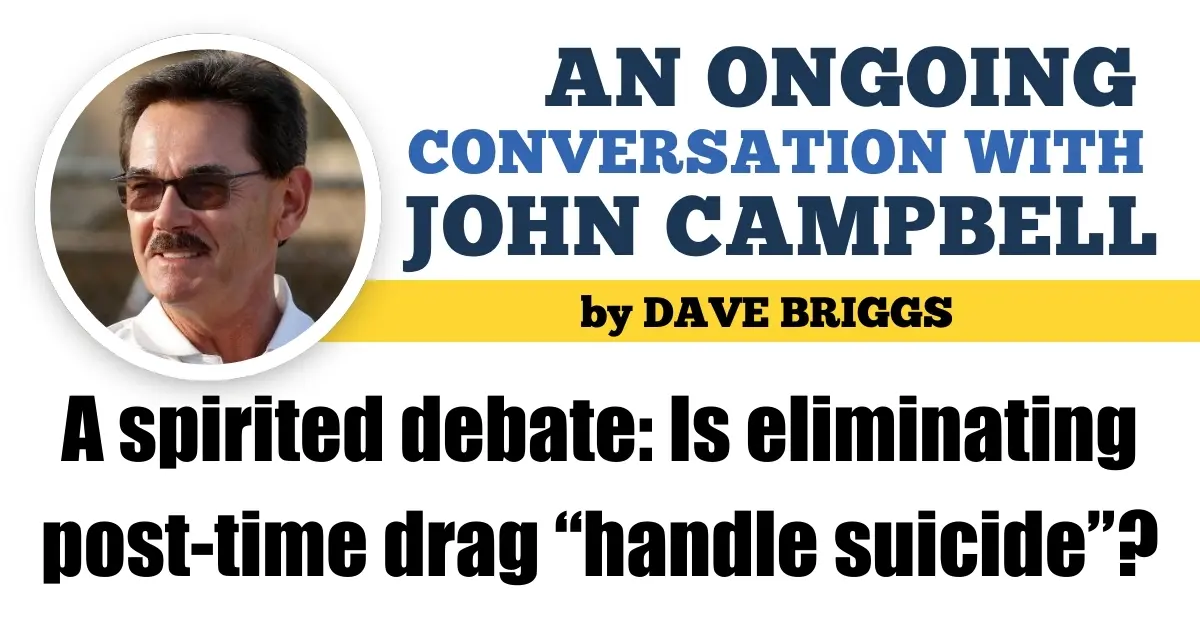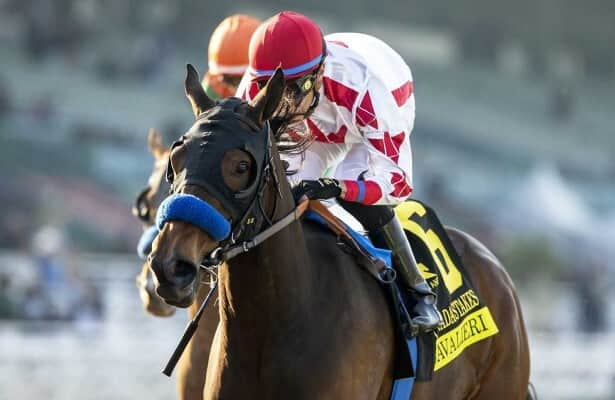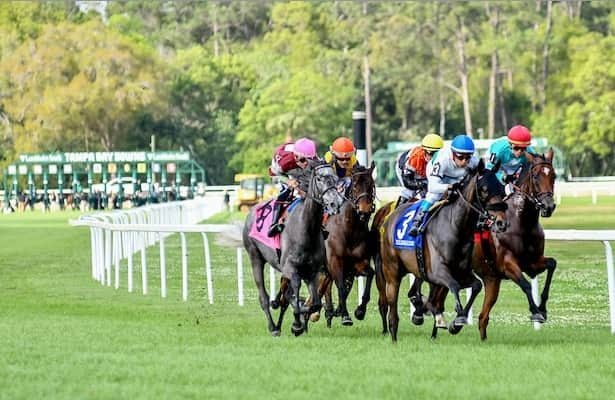A spirited debate: Is eliminating post-time drag “handle suicide”?

John Campbell says he isn’t a fan of post-time drag, but eliminating it would be disastrous to the sport. He also raises the threat of computer-assisted wagering.
by Dave Briggs
John Campbell reached out this week to say my slightly tongue-in-cheek column of Jan. 19 suggesting races should go off every 10 minutes at The Meadowlands would result in “handle suicide.”
In a wide-ranging conversation about what could improve the harness racing product, we didn’t agree on everything, but we agreed more than we disagreed — mostly on the fact that post-time drag is a scourge and computer-assisted wagering (CAW) is a threat.
The genesis of this column was to provide semi-regular access to a harness racing legend — now the CEO of the Hambletonian Society — and give him a forum for him to speak publicly to the industry on issues to which he was passionate. The point today is to give Campbell a chance to present an opposing view to my column.
But, since both of us are heavily invested in sustaining the sport we love, I thought it was also important to point out three times where I have an opposing view to Campbell’s. I do this out of deep respect for him to keep the wider, spirited dialogue going in the hope of pushing toward a better product for customers, participants and racetracks. At the end, we hope you share your thoughts with us.
To start, Campbell said, “There are two issues here that are really detrimental to the future of wagering on horse racing. This isn’t just harness racing, it’s thoroughbred as well — that’s the [post-time] drag and the CAWs. The problem that we have, and nobody likes drag — none of the participants, the bettors — but it’s proven that it does increase handle and if you don’t drag in the simulcast climate that we have now, you’re leaving money on the table.”
Campbell said he has consulted a number of handle experts at racetracks and they say any attempt to reduce drag has led to a reduction in handle.
“It’s been tried and it’s failed every time they shorten the time in between races or eliminate drag,” Campbell said. “It doesn’t work for the off-track. [Though the current] system doesn’t work for the on-track. I think the on-track [experience] would be better with the time in between races if they went on post. I think that is such a turn-off, to look at some tracks and see ‘1 minute to post’ and the horses aren’t even on the track. It’s an insult to their intelligence, but, at the same time, in the current system, that generates handle.
“If you’re running a racetrack, you’re trying to serve two masters. There’s your on-track clientele and their experience and the off-track, where the majority of the wager is coming from. You can’t serve both of those and make it a successful experience for either one. If you serve on-track, you’re off-track is going to suffer and if you service off-track, you’re on-track experience is going to suffer. That’s a conundrum for anybody running the racetrack.”
I don’t dispute the expertise of Campbell or the racetrack handle experts. I’m sure when the drag was reduced, handle decreased. But I also think there’s dozens of factors that determine handle and drag is only one of them. Saying that just one thing caused the handle to drop lacks thorough analysis. More importantly, I also don’t think the reduction of post-time drag has been done properly when it has been tried.
Even a track as prominent as The Meadowlands can’t simply reduce drag for a month or so and then give up when handle goes down. Since post time drag has long been the norm, we have to educate our customers and participants slowly on the change. For example, tell everyone the post-time drag will decrease by one minute every week until you get it to zero so people have time to adjust slowly. Constantly promote the change on your simulcast network, in the program and in the paddock and stick with the program for at least six months and then evaluate it.
Campbell said the problem is all the tracks have to agree to eliminate drag. It’s not in The Meadowlands’ best financial interests to go it alone.
“Until — and this will never happen unfortunately — you could get all of the tracks to go on post or within a minute of post, you’re never going to eliminate drag and it’s a terrible detriment to the future of wagering on horse racing,” Campbell said.
Fair. Of course, it’s better if everyone agrees to eliminate drag. But, I’m realistic, or maybe make that pessimistic. I know the other racing fiefdoms are mostly concerned about their own bottom line and less about the greater good of the sport or its customers and participants.
Though, I also argue The Meadowlands is in a unique position. A winning handle strategy for other tracks is staying off The Meadowlands’ post times because The Big M attracts the most bettor interest. The Meadowlands could just lead on this issue, eliminate the drag, and impose its will on the other tracks who will be forced to adjust to stay off The Big M’s races.
Campbell does not agree. He believes the only way it will work is if all the tracks eliminate drag and that counts the thoroughbred tracks, too, some of which are still racing during traditional harness racing slots. He may be right about that. I just think we’re underestimating the power of The Meadowlands in the simulcast universe.
We also talked about Sweden and France where, barring an unforeseen incident, races go exactly on the listed post time. Campbell said the problem there is the time between races is sometimes more than 30 minutes.
“They do go on post time, but they take plenty of time in between races,” Campbell said of French trotting races. “If you look at those Prix d’Amerique posts, they are 33 minutes or 35 minutes [between races]. They do take a long time… But I hate when we compare ourselves to them because that national footprint for harness racing is so much bigger over there than it is here.
“Everybody talks about how popular [harness racing] is in Europe, which it is, but, believe me, they struggle on an everyday basis to get people to the track at Vincennes and Solvalla. Everybody sees the Prix d’Amérique and the Elitlopp and the places are full. Well, they’ve marketed their big events and they get all those people there for them, but they are in the same boat as we are in terms of attracting people on a daily basis.”
My take is putting more time between our races and still going on the published post time is still better than what we have now. I realize it doesn’t solve my concern about the length of an entire harness racing card being far too long, but at least it’s not outright lying to our customers. It’s a start.
Campbell said you could increase the time between races and then go on the published post times, but only, “if you get all the tracks to do it… They all have to agree to it. Until that happens, the outliers would [continue to drag]. That’s just how the system works.”
He said, as it stands, the best strategy is to use big event days to market the sport to new or casual fans.
“Big events are the time to promote and get people to the track and make the on-track experience the best that it possibly can be and hope that we get some fans that grasp onto what we’re doing and will bet, whether they come back to the track or start following racing from home or their phone or tablet,” Campbell said.
His other main concern was the growing prominence of CAWs in the handle mix. Tracks need the handle money, but CAWs can be a detriment to regular customers betting and that’s bad for harness racing’s future. He believes CAW wagering should be cut off a few minutes before post time. We agree completely on the CAW threat.
“The average horseplayer that we’re trying to maintain, at this point, we’re driving out of both games,” Campbell said of standardbred and thoroughbred racing. “The computer-assisted wagering is just making it almost impossible for a regular horseplayer to make money. We’re driving those people out. At least they would have those two minutes to see where the money comes in and make a better decision on what he wants to bet.
“[If the tracks] would all agree that the CAW money has to be in by two minutes to post — and I’m not sure that’s the right number, but let’s say it is — then you wouldn’t have these wild odds swings when the horses are getting to the quarter. If they’d all do that, it would be so beneficial to the long-term future of horse racing, but [the tracks] won’t do that, either.
“If any single track or even a block of tracks tries to do either one of those things alone, it’s handle suicide.
“Let’s say, by some miracle, you got every track to agree that we’re going on post within the minute and the CAWs have to be in within two minutes, you could be sure that there would be some track that would start edging back their drag a little bit, edging back the amount of time for taking the CAWs. You just know they would do it. It’s a terrible detriment to the future of the sport, but, believe me, it’s thoroughbreds as well as us.
“It’s a horrible cycle that we’re on here between drag and CAW. That’s the issue, but it’s a racetrack issue that they have to address.”
On that, Campbell and I wholeheartedly agree. The sport has developed horrible habits on both and only racetracks can fix it.
“I couldn’t agree more that it’s a flawed system and they are dragging us down a terrible path, but I don’t know how to change it,” he said.
But while Campbell believes eliminating drag would be handle suicide, I believe failing to eliminate drag is suicide for the entire sport.
We’d love to hear your thoughts. Reach out to us via email at [email protected]
Related
Leading Parx jockey Sanchez will serve 7-day suspension
Photo: Jason Moran / Eclipse Sportswire Jockey Mychel Sanchez will serve a seven-day suspension and pay an additional $1,750 in fines
Bill Mott talks about plans for Sovereignty, Just F Y…
Photo: Gulfstream Park / Lauren King Sovereignty, dramatic late-running winner of the Fountain of Youth (G2) March 1, is being pointed
Up-and-coming Cavalieri chases Grade 1 glory in Beholder Mile
Photo: Santa Anita / Benoit Photo Cavalieri and Alpha Bella, who finished one-two in the Grade 3 La Cañada in January at Santa Anita,
4 stakes showcase shipping stars on Tampa Bay undercard
Photo: Gonzalo Anteliz Jr. / Eclipse Sportswire The stars will shine Saturday at Tampa Bay Downs, and not just in the Grade 3 Tampa Ba











